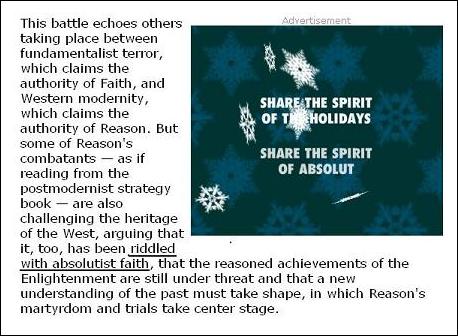See also earlier Pilgrim posts.
Wednesday, June 28, 2023
Tuesday, March 25, 2014
Narrative and Mathematics
"Richard Hughes’s celebrated short novel is
a masterpiece of concentrated narrative."
— New York Review of Books on
A High Wind in Jamaica
As perhaps were, in their way, parts of the life
of the late Patrice Wymore Flynn, who reportedly
died at 87 on Saturday.
Deep backstory: See Colony of Santiago (Jamaica).
For the "mathematics" part of this post's title, see
Saturday's Log24 post on Kummer-surface terms
and a post of September 23, 2012.
Sunday, March 23, 2014
Memorial Word
In memory of a Spanish statesman
who died today at 81… Santiago.
Monday, December 29, 2008
Monday December 29, 2008
A meditation for Becket’s Day on James Joyce, Santiago de Compostela, and the death of Pope John Paul II
Monday, December 11, 2006
Monday December 11, 2006
J. G. Ballard on “the architecture of death“:
“… a huge system of German fortifications that included the Siegfried line, submarine pens and huge flak towers that threatened the surrounding land like lines of Teutonic knights. Almost all had survived the war and seemed to be waiting for the next one, left behind by a race of warrior scientists obsessed with geometry and death.”
— The Guardian, March 20, 2006
“For him, writing is a struggle both with geometry and death.”
— “The Duende,” American Poetry Review, July/August 1999
absolute intellectual honesty,
and the effect is sheer liberation….
The disposition of the material is
a model of logic and clarity.”
— Harper’s Magazine review
quoted on back cover of
Cubism and Twentieth-Century Art,
by Robert Rosenblum
(Abrams paperback, 2001)
“Are Children the Ultimate Literary Critics?”
— Top of the News 29 (Nov. 1972): 32-36.
“Sets forth his own aims in writing for children
and laments ‘slice of life’ and chaos in
children’s literature. Maintains that children
like good plots, logic, and clarity,
and that they have a concern for
‘so-called eternal questions.'”
— An Annotated Listing of Criticism
by Linnea Hendrickson
“She returned the smile, then looked
across the room to her youngest brother,
Charles Wallace, and to their father,
who were deep in concentration, bent
over the model they were building
of a tesseract: the square squared,
and squared again: a construction
of the dimension of time.”
— A Swiftly Tilting Planet,
by Madeleine L’Engle

For “the dimension of time,”
see A Fold in Time,
Time Fold, and
Diamond Theory in 1937.
For a more adult audience —
In memory of General Augusto Pinochet, who died yesterday in Santiago, Chile, a quotation from Federico Garcia Lorca‘s lecture on “the Duende” (Buenos Aires, Argentina, 1933):
hermit of the Escorial,” is less lonely now.
Friday, July 1, 2005
Friday July 1, 2005
Big Dreams
“For more than a century, Los Angeles has been synonymous with big dreams. The Australian writer and critic Clive James said it this way. ‘Call Los Angeles any dirty name you like… The fact remains that you are already living in it before you get there.'”
— Today’s inaugural address by Mayor Villaraigosa
See also the previous entry.
Update of 2:24 PM July 2:
Yesterday afternoon I picked up a copy of George Steiner’s Grammars of Creation I had ordered. A check of Amazon.com to see what others had to say about this book yielded the following:
“Steiner’s account of Hope as something exclusively transcendental and relative to the future is poor and superficial: the person who hopes is not only walking ‘towards’ Eternal Life, but is already walking ‘in’ Eternal Life, walking the Kingdom.”
— Matías Cordero, Santiago, Chile
See also an entry of April 7, 2005, Nine is a Vine.
Saturday, December 20, 2003
Saturday December 20, 2003
White, Geometric, and Eternal
This afternoon's surfing:
Prompted by Edward Rothstein's own Fides et Ratio encyclical in today's NY Times, I googled him.
At the New York Review of Books, I came across the following by Rothstein:
"… statements about TNT can be represented within TNT: the formal system can, in a precise way, 'talk' about itself."
This naturally prompted me to check what is on TNT on this, the feast day of St. Emil Artin. At 5 PM this afternoon, we have Al Pacino in "The Devil's Advocate" — a perfect choice for the festival of an alleged saint.
Preparing for Al, I meditated on the mystical significance of the number 373, as explained in Zen and Language Games: the page number 373 in Robert Stone's theological classic A Flag for Sunrise conveys the metaphysical significance of the phrase "diamonds are forever" — "the eternal in the temporal," according to Stone's Catholic priest. This suggests a check of another theological classic, Pynchon's Gravity's Rainbow. Page 373 there begins with the following description of prewar Berlin:
"white and geometric."
This suggests the following illustration of a white and geometric object related to yesterday's entry on Helmut Wielandt:

Figure 1
(This object, which illustrates the phrase "makin' the changes," also occurs in this morning's entry on the death of a jazz musician.)
A further search for books containing "white" and "geometric" at Amazon.com yields the following:

Figure 2
From Mosaics, by
Fassett, Bahouth, and Patterson:
"A risco fountain in Mexico city, begun circa 1740 and made up of Mexican pottery and Chinese porcelain, including Ming.
The delicate oriental patterns on so many different-sized plates and saucers [are] underlined by the bold blue and white geometric tiles at the base."
Note that the tiles are those of Diamond Theory; the geometric object in figure 1 above illustrates a group that plays a central role in that theory.
Finally, the word "risco" (from Casa del Risco) associated with figure 2 above leads us to a rather significant theological site associated with the holy city of Santiago de Compostela:

Figure 3
Vicente Risco's
Dedalus in Compostela.
Figure 3 shows James Joyce (alias Dedalus), whose daughter Lucia inspired the recent entry Jazz on St. Lucia's Day — which in turn is related, by last night's 2:45 entry and by Figure 1, to the mathematics of group theory so well expounded by the putative saint Emil Artin.
"His lectures are best described as
polished diamonds."
— Fine Hall in its Golden Age,
by Gian-Carlo Rota
If Pynchon plays the role of devil's advocate suggested by his creation, in Gravity's Rainbow, of the character Emil Bummer, we may hope that Rota, no longer in time but now in eternity, can be persuaded to play the important role of saint's advocate for his Emil.
Update of 6:30 PM 12/20/03:
Riddled:
The Absolutist Faith
of The New York Times

White and Geometric, but not Eternal.

